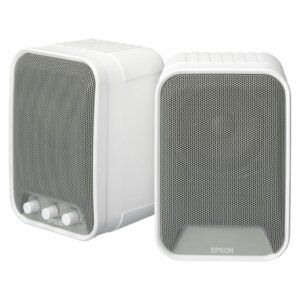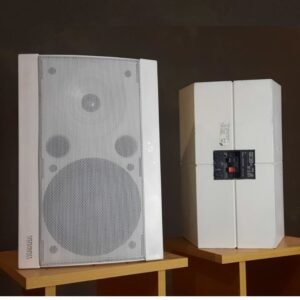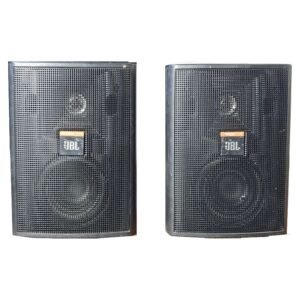Description
The JBL Control 25 is another highly popular model within JBL’s Control Contractor Series of passive installation loudspeakers. Similar to the Control 23, it’s designed for background/foreground music and paging in commercial environments, but with a larger woofer (5.25 inches instead of 3 inches), providing more output and deeper bass response.
The most common modern iteration is the JBL Control 25-1. There’s also the Control 25AV which is an older, but still found, variant with additional shielding and slightly different specifications (e.g., typically designed for video applications). I will focus on the Control 25-1 as it’s the more prevalent current model for general installation.
Key Features and Specifications (per single loudspeaker):
- Type: Passive Two-Way Loudspeaker. Requires an external amplifier.
- Drivers:
- LF Driver: 5.25-inch (135mm) woven-fiberglass cone woofer with pure butyl rubber surround and WeatherEdge™ frame protection. This larger woofer provides enhanced bass response compared to the Control 23-1.
- HF Driver: 0.75-inch (19mm) PEI (Polyetherimide) diaphragm tweeter with fluid cooling.
- Power Handling:
- Continuous Program Power: 200W (for 2 hours)
- Continuous Pink Noise: 100W (for 2 hours) / 75W (for 100 hours)
- Peak Power: 400W
- Impedance: 8 ohms (in “Thru” or direct mode).
- Transformer Taps (for models with transformers like Control 25-1T or standard 25-1 which includes it): Most Control 25-1 models include a built-in multi-tap transformer for use in 70V or 100V distributed audio systems. Common taps include 30W, 15W, 7.5W, and 3.7W. This is crucial for large-scale commercial installations.
- Frequency Range (-10dB): 60 Hz to 20 kHz. This extended low-frequency response gives it more fullness for music playback than the Control 23.
- Frequency Response (±3dB): 85 Hz – 17 kHz.
- Sensitivity (1W, 1m): 90 dB. This is a higher sensitivity than the Control 23, meaning it can achieve a higher SPL with the same amount of amplifier power.
- Maximum SPL (1m): 110 dB average continuous pink noise (116 dB peak).
- Coverage Angle: Wide 100° x 100° coverage, ensuring broad and consistent sound distribution.
- Weather Resistant:
- Designed for both indoor and outdoor use.
- Conforms to Mil Spec 810 for humidity, salt spray, temperature & UV.
- IEC 529 IP-44 splashproof rating (can be upgraded to IP-55 with optional grilles/covers like the WeatherMax™ grille).
- Grilles are heavily zinc-plated and powder-coated for rust resistance.
- Mounting:
- InvisiBall™ Mounting Hardware: Integrated, patented system for easy, secure, and highly adjustable wall mounting with a discreet appearance. Offers excellent rotation (high degree of vertical and horizontal rotation).
- Optional U-bracket (MTC-25UB-1) and ceiling-mount adapter (MTC-28/25CM) are available.
- Enclosure Material: High-Impact Polystyrene (HIPS), paintable.
- Connectivity: Screw-down terminal strip (accepts bare wire or spade lugs).
- Dimensions (H x W x D): 243 x 188 x 145 mm (9.6 x 7.4 x 5.7 in). Slightly larger than the Control 23-1.
- Net Weight (each): 3.4 kg (7.5 lbs).
JBL Control 25-1 vs. JBL Control 23-1 (Key Differences):
The Control 25-1 is essentially a step up from the Control 23-1, offering:
- Larger Woofer: 5.25″ vs. 3″ results in significantly deeper bass response.
- Higher Power Handling: 200W vs. 100W Continuous Program Power.
- Higher Sensitivity: 90 dB vs. 86 dB, meaning it gets louder with less amplifier power.
- Higher Max SPL: 110 dB vs. 103 dB, making it suitable for louder foreground music applications.
- Broader Frequency Range: Extends lower to 60 Hz (-10dB) compared to 70 Hz for the Control 23-1.
- Slightly Larger Dimensions and Weight.
Common Applications:
The JBL Control 25-1 is highly versatile and used in a wide array of commercial and public spaces where higher fidelity and output are desired than the Control 23-1:
- Retail Stores: Especially larger ones, or where music is a more prominent part of the ambiance.
- Restaurants & Bars: Providing clear background/foreground music.
- Fitness Centers/Gyms: Often used in workout areas.
- Conference Rooms & Boardrooms: For clear speech and presentation audio.
- Hotels: Lobbies, common areas, ballrooms.
- Museums & Galleries: For ambient soundscapes or guided audio.
- Houses of Worship: For overflow rooms or smaller chapels.
- Outdoor Patios & Gardens: Due to excellent weather resistance.
- Schools & Universities: Auditoriums, larger classrooms, cafeterias.





















